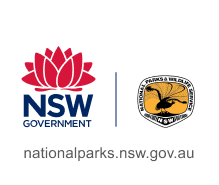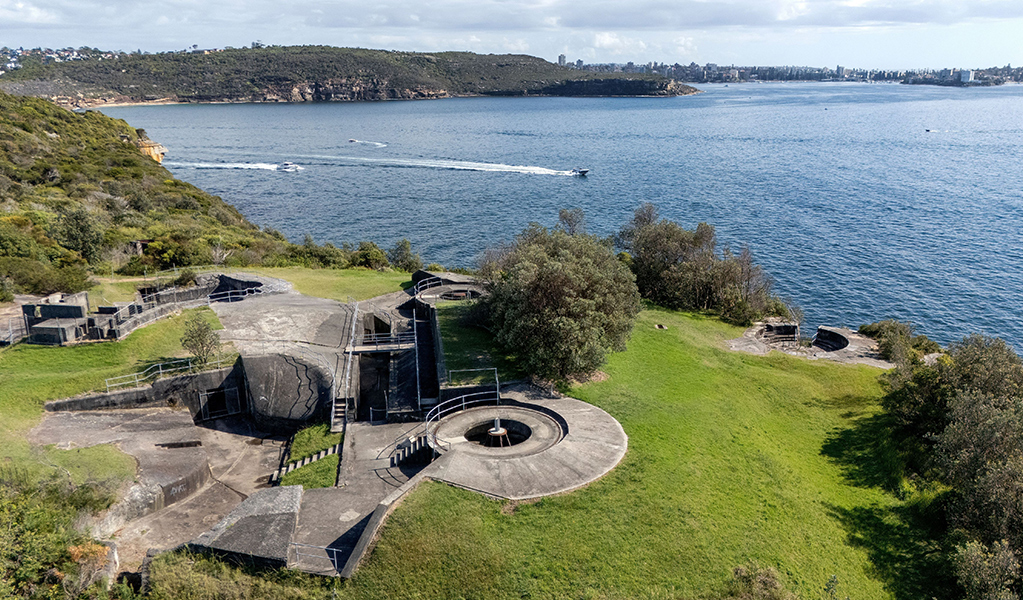Overview
Middle Head – Gubbuh Gubbuh ('gub-uh, gub-uh) is one of Sydney Harbour's 7 headlands. Enjoy scenic views of Sydney Harbour from the lookout or explore the historic fort and military relics.
- Type
- Lookouts
- Accessibility
- Medium
- Entry fees
-
If you have a NPWS All Parks Pass or Multi Parks Pass you can park free for up to 4 hours per day along sections of Chowder Bay Road.
- What to
bring - Drinking water, sunscreen, hat, binoculars, sturdy shoes
- Hire this venue
Middle Head is available for events and function hire.
- Please note
- There's no vehicle access to Middle Head. Paid parking is available 100m away on Middle Head Road or Chowder Bay Road.
- Between June and September the tunnels are occupied by bent-wing bats that hibernate here.
Middle Head – Gubbah Gubbah is a superb lookout in Sydney Harbour National Park. From this outstanding vantage point you can follow ocean views to the horizon, framed by North and South Heads. The panoramic view extends to Sydney's eastern suburbs, Middle Harbour and Manly.
In addition to sensational views, you can learn about Middle Head's military significance. Follow Govenors Road past the of 19th century cottages to the Inner Middle Head Fort. Here you’ll find 2 large gun emplacements sitting atop a tunnel network once used for shelter and ammunition storage.
Continue south to Outer Middle Head and explore the maze of gun emplacements, canons, ‘tiger cages’ and structures dating from the 1800s to 1960s, built to protect Sydney from potential invasion. Discover what life was like for the people who trained and worked here. Gain new insights with historic photographs, interpretive signage, and online videos.
On a hot day you might want to wander down to Cobblers Beach (nude bathing permitted) for a dip and enjoy this picturesque cove. But if you prefer a few hours of gentle hiking instead, follow the Middle Head – Gubbuh Gubbuh to Georges Head walking track which guides you 3km to Georges Head.
If you're pressed for time and prefer a shorter walk, take the Don Goodsir track to the 1801 battery, the oldest fort built on the headland, in response to a feared French invasion. From here you can return back up the hill to Middle Head.
You can also take a virtual tour of Middle Head captured with Google Street View Trekker.
Also see:
-

Middle Head Officers Quarters
Going to a wedding or looking for a secluded getaway in Sydney Harbour National Park? Middle Head Officers Quarters is close to the action but in its own world – only minutes from Mosman village and Taronga Zoo.
-

Middle Head - Gubbuh Gubbuh to Georges Head walking track
This 3km walk threads its way along the harbour’s edge from Middle Head – Gubbuh Gubbuh to Georges Head. Rich in historic heritage, explore forts and casemates while enjoying dazzling views of Sydney Harbour.
-

Middle Head
With expansive water views across iconic Sydney Harbour and stretching out to Sydney’s eastern suburbs, Middle Harbour and Manly - Middle Head will impress your guests at your next product launch, conference or wedding ceremony.
Map
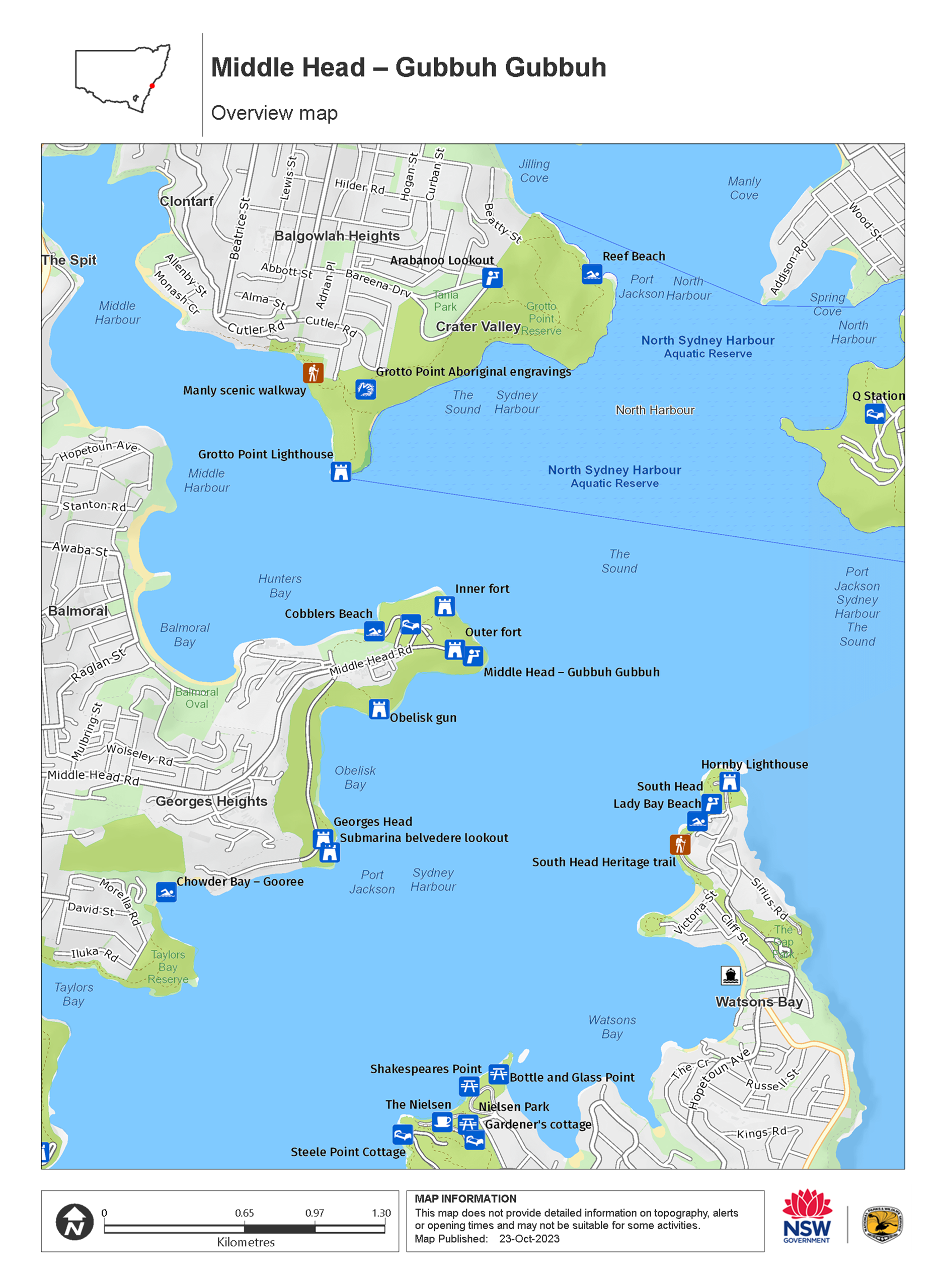
Map legend
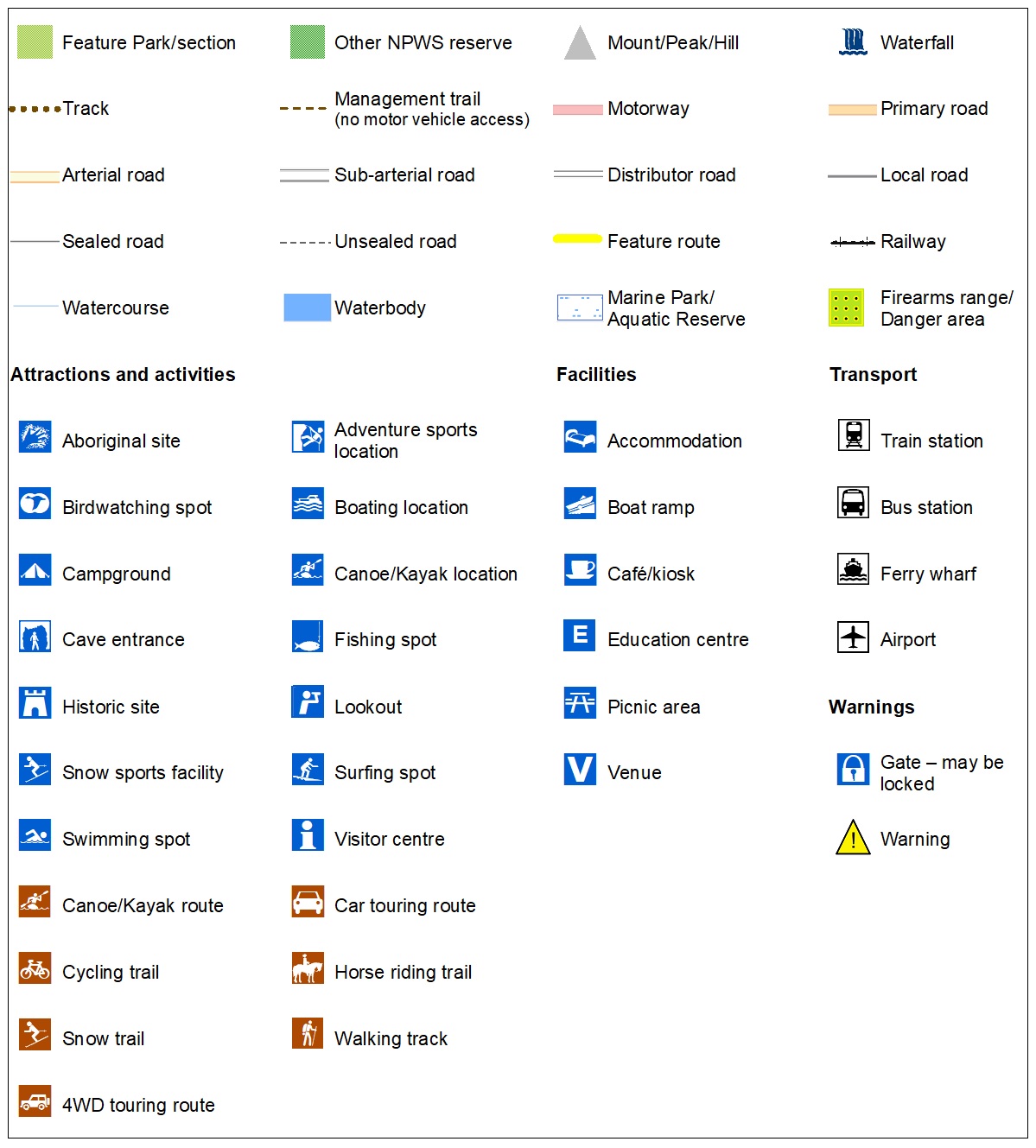
Local alerts
For the latest updates on fires, closures and other alerts in this area, see https://www.nationalparks.nsw.gov.au/things-to-do/lookouts/middle-head-gubbuh-gubbuh/local-alerts
General enquiries
- National Parks Contact Centre
- 7am to 7pm daily
- 1300 072 757 (13000 PARKS) for the cost of a local call within Australia excluding mobiles
- parks.info@environment.nsw.gov.au
Park info
- in Sydney Harbour National Park in the Sydney and surrounds region
Sydney Harbour National Park is open sunrise to sunset but may have to close at times due to poor weather or fire danger.
-
Park entry fees:
Bradleys Head: $8 per vehicle per day. North Head: $5 per vehicle per day. Tap and pay card or phone payments accepted at pay machines. Coin payment available at Fairfax carpark machines only. Chowder Bay: Monday-Friday: $3 per hour, to a maximum of $16 per day. Saturday, Sunday and Public Holidays: $4 per hour, to a maximum of $20 per day. If you hold an NPWS All Parks or Multi Parks Pass, you can park free for up to four hours per day - additional time can be purchased. Car parks operated by Sydney Harbour Federation Trust or Mosman Council are not covered by your pass. Please check signs carefully. Park’nPay: You can also pay for your visit to any area via the Park’nPay app.
Other fees:
Landing fees or tour fees apply to visit Sydney Harbour islands. All public visitors to Shark, Clark or Rodd Island, need to pay a $7 per person landing fee. To arrange, please contact 1300 072 757 (13000 PARKS). Annual NSW Parks Passes do not cover landing fees.
Buy annual pass.
Visitor info
All the practical information you need to know about Middle Head – Gubbuh Gubbuh.
Getting there and parking
Get driving directions
Middle Head is in the Middle Head precinct of Sydney Harbour National Park. To get there:
- From Mosman, follow Middle Harbour Road to the end.
- It's approximately 100m walk from the carpark to Middle Head Forts and lookout
Road quality
- Sealed roads
Vehicle access
- 2WD vehicles
Weather restrictions
- All weather
Parking
Paid parking is available at Middle Head carpark, including 3 accessible parking spaces. Follow Middle Head Road past the Chowder Bay Road roundabout, to the Sydney Harbour Federation Trust managed carparks.
Four hours free parking is available for NPWS Annual Pass holders along sections of Chowder Bay Road. Please check the parking meter for the NPWS logo to ensure your vehicle is parked in an NPWS managed carpark.
By public transport
Accessible bus services stop near the forts. Contact the Transport Information Line on 131500 for more information.
Facilities
Toilets
- Flush toilets
Drinking water
Step-free access
- There's step-free access along bitumen Old Fort Road, which leads to a flat grassy area. From here, you can enjoy the view and see some of the fortifications.
- There are some points where the grass becomes a rock platform.
- A number of the forts have stone steps, most without handrails, leading inside the tunnels and gun pits.
- Step-free outdoor pathways
Maps and downloads
Accessibility
Disability access level - medium
There's step-free access to Middle Head forts along bitumen Old Fort Road, which leads to a grassy area where you can see some of the structures and take in the view.
Assistance may be required in some places:
- A number of the forts have stone steps, most without handrails, leading inside the tunnels and gun pits
- Some areas are moderately to very steep
- There are flush toilets at the forts, but there's a step to reach them and the toilets themselves are not accessible or ambulant.
For venue hire, vehicle access for disabled visitors can be arranged with prior notice.
Permitted
Obelisk and Cobbler beaches at Middle Head are clothing-optional beaches.
Prohibited
Pets
Pets and domestic animals (other than certified assistance animals) are not permitted. Find out which regional parks allow dog walking and see the pets in parks policy for more information.
Smoking
NSW national parks are no smoking areas.
Learn more
Middle Head – Gubbuh Gubbuh is in Sydney Harbour National Park. Here are just some of the reasons why this park is special:
A world of history

Although British authorities first planned to set up their penal colony in Botany Bay, the First Fleet of convicts only stayed in Botany Bay for a few days and then set sail around the coast to Sydney Harbour, where the colony was established. Since then, Sydney Harbour has continued to play an important part in the development of the nation and a number of places in the park have strong links to Sydney's history. You'll find buildings constructed using convict labour, maritime and military fortifications, and the Quarantine Station which once housed new boat arrivals to Sydney, protecting Sydneysiders from infectious disease.
- Bradleys Head guided walking tour in Sydney Join your friendly guide from EcoWalks Tours for a fascinating harbour-side excursion at Bradleys Head in Sydney. You'll experience local history, enjoy stunning views and see native wildlife.
- Bushland secrets at Bradleys Head self-guided tour Take a self-guided tour around Bradleys Head and discover the hidden secrets of this special place. Stroll through bushland along an elevated boardwalk and learn about the history of the area as you drink in the magnificent views of Sydney Harbour.
- Convict kids on Goat Island 'Guilty of petty theft – your punishment is penal transportation to Australia for the term of your natural life.' Discover what life was like for the first convicts of Australia in this unique Stage 2 (Years 3-4) History excursion on historic Goat Island.
- Fort Denison – Muddawahnyuh Fort Denison – Muddawahnyuh (mud-uh-'wahn-yuh) is a heritage fort on a Sydney Harbour island. Once a penal site called Pinchgut Island, the original rocky outcrop was fortified as a military facility in the 1840s and added to Sydney Harbour National Park in 1995.
- Georges Head and Obelisk Casemates It's the year 1942, and Sydney Harbour is under threat from torpedo boats during WW2. Watch this animation to see the twin 6-pounder gun protect Sydney from the Georges Head and Obelisk batteries
Aboriginal culture and heritage

Before Australia became a British colony, the area around Sydney Harbour was occupied by the Eora and Daruk Aboriginal Nations. Upon the arrival of settlers and convicts, land was cleared to make way for the developing colony, and Aboriginal people were forced further and further away from their traditional camping and hunting grounds. As the colony spread, more evidence of Aboriginal life and culture was destroyed. Today, despite the great spread of the city, you can find many Aboriginal sites like rock engravings and middens - examples of an ancient and enduring cultural heritage and a record of the Eora Peoples' culture.
Burragula and Yiningma lookouts were designed to reflect Aboriginal connection to Country. They’re a great spot to share stories while relaxing on the beautiful sandstone seating in the shape of a bara or fishhook.
- Arabanoo lookout at Dobroyd Head Arabanoo lookout at Dobroyd Head is named in honour of Arabanoo, the first Aboriginal man to live among European settlers. It's a great spot for whale watching, offering views over North and South Head and the Pacific Ocean.
- Grotto Point Aboriginal engraving site Sydney Harbour National Park’s rock engravings immerse you in Sydney’s Aboriginal heritage. Head to Grotto Point at Dobroyd Head for historic rock art and scenic views.
- Hawkesbury to harbour walk: Stage 5 Explore the sights of Sydney Harbour national park on this 11km guided tour. You’ll walk for 5.5hrs from the Spit Bridge to Manly, taking in some of Sydney’s most iconic coastline.
- Living world WildTracker: Bradleys Head On a WildTracker excursion, Stage 3 (Years 5-6) students investigate and analyse the natural environment of Bradleys Head. Students identify and group species and discuss adaptations that help these species survive and thrive here.
- Living world WildTracker: Nielsen Park On a WildTracker excursion, Stage 3 (Years 5-6) students will explore and analyse the natural environment of Nielsen Park. We'll identify and group species and discuss the adaptations that help these species survive and thrive here.
An island paradise

The park protects five historic harbour islands. Discover the rich convict and maritime heritage of Me-Mel or Goat Island, along with stunning views from all angles. Why not picnic at Rodd or Shark Island? Set aside for public enjoyment as early as 1879, both offer picnic areas, beaches and paths for you to explore. The park’s exceptional landscapes are the perfect setting for fishing, swimming, and soaking up the views. Head to Clark Island for an Aboriginal cultural experience or enjoy the city lights when you stay at Middle Head Officers Quarters. Sydney Harbour National Park is beloved by landscape photographers, so why not bring your camera and take a few shots?
- Arabanoo lookout at Dobroyd Head Arabanoo lookout at Dobroyd Head is named in honour of Arabanoo, the first Aboriginal man to live among European settlers. It's a great spot for whale watching, offering views over North and South Head and the Pacific Ocean.
- Bradleys Head – Booraghee Amphitheatre Bradleys Head – Booraghee ('boo-ruh-gee) Amphitheatre is an exceptionally popular place within Sydney Harbour National Park. A fabulous lookout, it's also a great picnic area and fishing spot.
- Bradleys Head to Chowder Bay walk Take the Bradleys Head to Chowder Bay walk for beautiful views of Sydney Harbour. This easy walk takes you from Taronga Zoo to the beach and cafes at Chowder Bay.
- Fairfax walk Fairfax walk is paved, making it an easy stroll and ideal for walking with children. Located at North Head in Sydney Harbour National Park, it's a great walk for whale watching.
- Luxury 3-day Sydney Harbour hiking tour Experience the best of Sydney Harbour National Park on this luxury multi-day hike with Harbour Trax. From scenic walks to gourmet dining and boutique accommodation, it’s the ultimate Sydney adventure.
Diverse landscapes

You'll find everything from sandstone cliffs and rocky foreshores to quiet beaches and bushland in Sydney Harbour National Park. Cliff instability and rockfalls have shaped Sydney's dramatic coastline over thousands of years. Visit the lookouts at North Head and enjoy the perfect vantage point for whale watching. With panoramic views you'll be able to absorb the sheer size of Sydney Harbour. Explore the bushland at Nielsen Park, South Head, Bradleys Head or along the Manly scenic walkway and find yourself beneath gigantic Sydney red gums and Port Jackson figs.
- Aboriginal cultural cruise in Sydney Harbour Join the friendly and knowledgeable guides of Tribal Warrior for a fascinating boat and island tour as you learn about the Aboriginal culture of Sydney Harbour.
- Bottle and Glass Point Bottle and Glass Point is an ideal picnic spot in Nielsen Park in Sydney’s Eastern Suburbs. Enjoy lovely harbour views and relax in Sydney Harbour National Park.
- Bradleys Head guided walking tour in Sydney Join your friendly guide from EcoWalks Tours for a fascinating harbour-side excursion at Bradleys Head in Sydney. You'll experience local history, enjoy stunning views and see native wildlife.
- Guided kayak tours at Manly Beach Join the friendly local guides of Manly Kayak Centre for an unforgettable paddle and scenic walk. From ocean to hilltop, it’s a great way to enjoy the highlights of Sydney’s beautiful North Harbour, near Manly Beach.
- Manly hiking tour Join Fit City Tours for a guided hike in Sydney Harbour National Park. Setting out from Manly, you’ll walk for 10km along a rugged coastal track with iconic harbour views.
Native birds and animals

You'll probably spot at least one of the park's 150 bird species on your visit, like a white-bellied sea eagle or a New Holland honeyeater. If you're near Manly, you may be lucky enough to glimpse an endangered little penguin as it is the state's only known mainland colony. If you happen to see unusual webbed footprints on a beach or shoreline, they may well belong to a native water rat looking for seafood in shallow water close to the shoreline.
- Aboriginal cultural cruise in Sydney Harbour Join the friendly and knowledgeable guides of Tribal Warrior for a fascinating boat and island tour as you learn about the Aboriginal culture of Sydney Harbour.
- Bradleys Head guided walking tour in Sydney Join your friendly guide from EcoWalks Tours for a fascinating harbour-side excursion at Bradleys Head in Sydney. You'll experience local history, enjoy stunning views and see native wildlife.
- Fairfax walk Fairfax walk is paved, making it an easy stroll and ideal for walking with children. Located at North Head in Sydney Harbour National Park, it's a great walk for whale watching.
- Hawkesbury to harbour walk: Stage 5 Explore the sights of Sydney Harbour national park on this 11km guided tour. You’ll walk for 5.5hrs from the Spit Bridge to Manly, taking in some of Sydney’s most iconic coastline.
- Living world WildTracker: Bradleys Head On a WildTracker excursion, Stage 3 (Years 5-6) students investigate and analyse the natural environment of Bradleys Head. Students identify and group species and discuss adaptations that help these species survive and thrive here.
Plants and animals protected in this park
Animals
-

Humpback whale (Megaptera novaeangliae)
The humpback whale has the longest migratory path of any mammal, travelling over 5000km from its summer feeding grounds in Antarctica to its breeding grounds in the subtropics. Its playful antics, such as body-rolling, breaching and pectoral slapping, are a spectacular sight for whale watchers in NSW national parks.
Plants
-

Grass tree (Xanthorrea spp.)
An iconic part of the Australian landscape, the grass tree is widespread across eastern NSW. These Australian native plants have a thick fire-blackened trunk and long spiked leaves. They are found in heath and open forests across eastern NSW. The grass tree grows 1-5m in height and produces striking white-flowered spikes which grow up to 1m long.
-

Blueberry ash (Elaeocarpus reticulatus)
The blueberry ash is a rainforest shrub which produces blue olive-shaped berries and spectacular bell-shaped flowers, which often appear on the plant together. It is a tall slender shrub or small tree found in rainforest, tall eucalypt forest and coastal bushland in eastern NSW, south-east Queensland and Victoria.
-
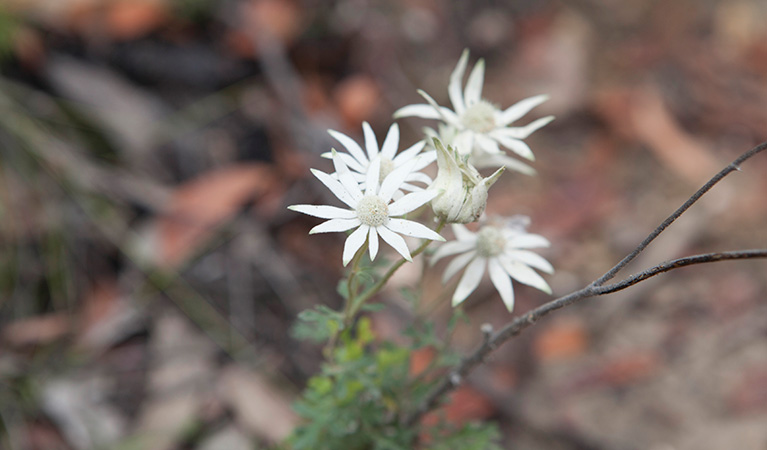
Flannel flower (Actinotus helianthi)
The delicate flannel flower is so named because of the soft woolly feel of the plant. Growing in the NSW south coast region, extending to Narrabri in the Central West and up to south-east Queensland, its white or pink flowers bloom all year long, with an extra burst of colour in the spring.
-

Smooth-barked apple (Angophora costata)
Smooth-barked apple gums, also known as Sydney red gum or rusty gum trees, are Australian native plants found along the NSW coast, and in the Sydney basin and parts of Queensland. Growing to heights of 15-30m, the russet-coloured angophoras shed their bark in spring to reveal spectacular new salmon-coloured bark.
Environments in this park
School excursions (8)
- Convict kids on Goat Island, Stage 2 (Years 3-4), History
- The earth’s environment at Bradleys Head , Stage 2 (Years 3-4), Geography
- The earth's environment at Arabanoo lookout, Stage 2 (Years 3-4), Geography
- The earth's environment at Bradleys Head, Stage 1 (Years 1-2), Geography
- Living world WildTracker: Bradleys Head, Stage 3 (Years 5-6), Science and Technology
- Living world WildTracker: Nielsen Park, Stage 3 (Years 5-6), Science and Technology
- The earth's environment at Nielsen Park, Stage 2 (Years 3-4), Geography
- WildThings at Bradleys Head, Stage 1 (Years 1-2), Science and Technology
